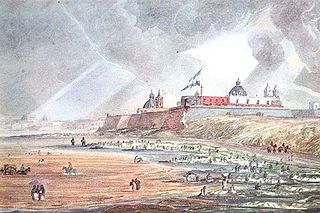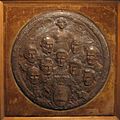
San Telmo is the oldest barrio (neighborhood) of Buenos Aires, Argentina. A well-preserved area of the Argentine metropolis, it hosts some of its oldest buildings. One of the birthplaces of tango, during the 60s and 70s it became the Bohemian district with painters ateliers and jazz clubs. Cafes, tango parlors and antique shops line the cobblestone streets, which are often filled with street artists and dancers.

The following is an alphabetical list of topics related to the Argentina.

According to the World Travel & Tourism Council (WTTC) the travel and tourism sector of Argentina was moving towards recovering its pre-covid pandemic contribution to GDP in mid-2023, led by Buenos Aires.
Alfredo Prior is a painter, writer, performer and musician. His career began at the age of 18 with his first solo exhibition in Buenos Aires, where he still lives and works.

Lezama Park is a public park in the San Telmo district of Buenos Aires, Argentina.

The Buenos Aires Museum of Modern Art, known locally as the Museo de Arte Moderno de Buenos Aires (MAMBA), is a modern art museum located in the San Telmo district of Buenos Aires, Argentina.
The curved saber of San Martín is a historic weapon used by José de San Martín.

Hotel de Inmigrantes is a complex of buildings, often compared to a citadel, constructed between 1905 and 1911 in Buenos Aires, Argentina to receive immigrants and stem the tide of communicable diseases following mass cholera outbreaks across the globe. The hotel, which saw more than a million immigrants pass through during its 42 years, now houses the National Museum of Immigration as well as the National University of Tres de Febrero's Contemporary Art Center.

Manuel Espinosa was an Argentinian painter.

The flag of Macha is the name given to a pair of flags of Argentina found at a chapel in the hamlet of Titiri, near the village of Macha, north of Potosí, Bolivia. They are considered to be the first physical flags created by Manuel Belgrano, who in November 1813 hid the standards to prevent them from falling into enemy hands after the United Provinces' army defeat of Ayohuma. They were discovered in 1885. Bolivia kept one of those flags at Sucre; the other was given to Argentina in 1896 and is currently kept at the National Historical Museum. Tucumán Province has used it as provincial flag since 2010. The flag preserved in Argentina is a triband of blue, white and blue bands, like the modern flag of Argentina, but the one kept in Bolivia is a triband of white, blue and white.

Adolfo Carranza was an Argentine lawyer, public official, historian, and writer who established the National Historical Museum.
Julio Mario Luqui-Lagleyze is an Argentine historian. Born in Buenos Aires in 1959 received a degree in History in 1982. He specializes in Hispano-American Military and Naval History and Military Museology. He is currently studying for his PhD in History at the Universidad Católica Argentina.

Manuel Canaveris was an Argentine army officer, who took part in the defense and reconquest of Buenos Aires during the English Invasions. He served under Colonel Ignacio Álvarez Thomas in the 4th Regiment of Buenos Aires, participating in the Campaigns to the Interior of the Provinces of 1810.

Isabelino Canaveris was an Uruguayan patriot, military, revolutionary and politician, who served as president of the National Party in the Argentine Republic. He participated in most of the armed confrontations between the Blancos and Colorados.

Rogelio Polesello was an Argentine painter, muralist and sculptor. He was best known for making Op art known in Latin America. He won two Konex Awards; one in 1982 and another in 2012. He was born in Buenos Aires.

Alejandro Pablo Avelluto is a journalist and book editor who held the office of Minister for Culture of Argentina since 10 December 2015 to September 2018, appointed by Mauricio Macri. Between 2014 and 2015 he served as General Coordinator of the Public Media System of the Autonomous City of Buenos Aires.

Juan Nicolás Melé was an Argentine sculptor, painter, and art critic. Melé was a member of the Asociación Arte Concreto-Invención as well as co-founder of the Grupo Arte Nuevo.

The Fort of Buenos Aires was a fortress destined to defend Buenos Aires and to be the seat of the Spanish colonial authorities in the city. Its construction began in 1595 and after several refurbishments it was finished only at the beginning of the 18th century, being demolished in 1882. It received the name of Real Fortaleza de Don Juan Baltasar de Austria, and in the 17th century it was called Castillo de San Miguel Arcángel del Buen Ayre.

Eugenia Belín Sarmiento was an Argentinean painter and author. Her works were featured in various international shows, among them the first Exposición Anual de Pintura, Dibujo y Escultura for artists of South America in 1893. Critical response to her works has often focused attention on her portraits of her grandfather, Domingo Faustino Sarmiento, who was president of Argentina from 1868 to 1874. Eugenia completed many other works as well, including miniatures as well as full size portraits, paintings of flowers, birds, and still lives, and sculptures.



































